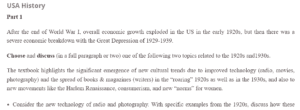USA History
Part One: The Great Depression
During the great depression, Franklin Delano Roosevelt was the President of the United States who promised to help the country out of the recession with the New Deal. With the new agreement, Roosevelt hoped to help the economically oppressed folks of the land. He started by addressing the nation after he was sworn in. He encouraged the people that they needed to be bold enough to face the situation as it would be the only way to defeat the depression. Roosevelt ordered the closure of all banks, made the prices of gold go up by banning the privatization of gold, and imposed restrictions on the production and marketing of agricultural products. All these changes made the depression worse because they led to an increase in the prices of various products, such as farm products (Higgs, 1995). Our assignment writing help is at affordable prices to students of all academic levels and academic disciplines.
Part Two: Isolationism in the United States
President Roosevelt hoped to save the United States from the economic depression by isolating it from the rest of the world. He did so by imposing import tariffs that discouraged international trade. Also, he discouraged the trade in firearms in the bid to remain a neutral party in case another war erupted. His policies proved to work in the short run, but in the long term, they were not applicable. Later, the United States needed agricultural products from Britain due to inadequate production in the country and also required to trade firearms to Britain during the war that erupted later in 1939 (Office of the Historian, 2018). Even with the invasion of Japan by the United States, the states had no option but to participate in international conflict. They also had to support Britain in the war for economic benefits.
References
Higgs, R. (1995). How FDR made the depression worse. The free market. Retrieved from https://mises.org/library/how-fdr-made-depression-worse
Office of the Historian. (2018). American isolationism in the 1930s. Retrieved from state.gov: https://history.state.gov/milestones/1937-1945/american-isolationism
ORDER A PLAGIARISM-FREE PAPER HERE
We’ll write everything from scratch
Question
USA History
Part 1
After the end of World War I, overall economic growth exploded in the US in the early 1920s, but then there was a severe economic breakdown with the Great Depression of 1929-1939.
Choose and discuss (in a full paragraph or two) one of the following two topics related to the 1920s and1930s.
The textbook highlights the significant emergence of new cultural trends due to improved technology (radio, movies, photography) and the spread of books & magazines (writers) in the “roaring” 1920s as well as in the 1930s, and also to new movements like the Harlem Renaissance, consumerism, and new “norms” for women.
- Consider the new technology of radio and photography. With specific examples from the 1920s, discuss how these new technologies helped one of the movements and trends above.
- Explain whether you think this helped to develop a more unified national culture or more individuality, and identify a similar example today with technology helping a trend or movement.
- Identify the source(s) where you read about the trend of the 1920s.
USA History
- The Great Depression (1929-1939) was one of the most devastating economic downturns that America has ever experienced. Determine whether you believe that the federal responses to the Great Depression by President Franklin Roosevelt encouraged real economic growth and confidence or whether the arguments by critics of the day were accurate that it made the Depression last longer.
- Identify your position and support it with at least two specific examples of New Deal responses.
- Provide a rationale for your response.
- From this historical experience, identify any lessons for today for handling or avoiding severe economic downturns in the U.S. economy.
- Identify the source(s) where you read about the New Deal responses.
Number of pages: 1/2
References/sources: 1
Part 2
By the late 1930s, the US was still dealing with the Great Depression, and conflict was intensifying between powers in Europe and between Japan and its neighbors in Asia. At first, isolationist sentiments prevailed, but eventually the US entered the conflict. Besides developments of the overseas conflict, the next few years of a “war economy” had an enormous impact on the nature of work and the workforce that left a lasting legacy.
Choose and discuss one of the following two topics related to the American experiences in World War II:
- Focusing on American opinions and events of the late 1930s and early 1940s, discuss isolationist views and why those changed.
- Identify two isolationist arguments for staying out of World War II.
- Describe the events that led us into war despite the isolationist views. What lessons can be drawn from this experience for our modern day concerns about war and when to engage in it.
- Identify the source(s) where you read about the New Deal responses.
- In the period 1940-1945, the US would go into a “war economy” that dramatically impacted the American economy and society.
- Give two examples of changes during the “war economy” period
- Describe the impact on US society and work during the war years
- Taking the long term view, explain ways our society is different due to the wartime experiences.
- Identify the source(s) where you read these changes during World War II.
Number of pages: 1/2
References/sources: 1


